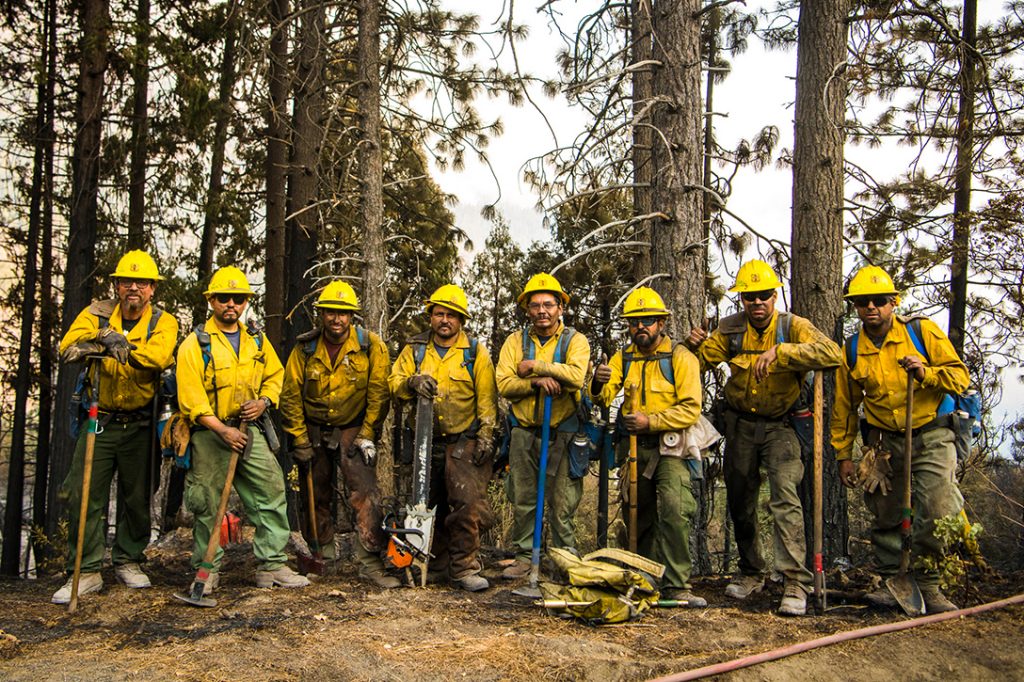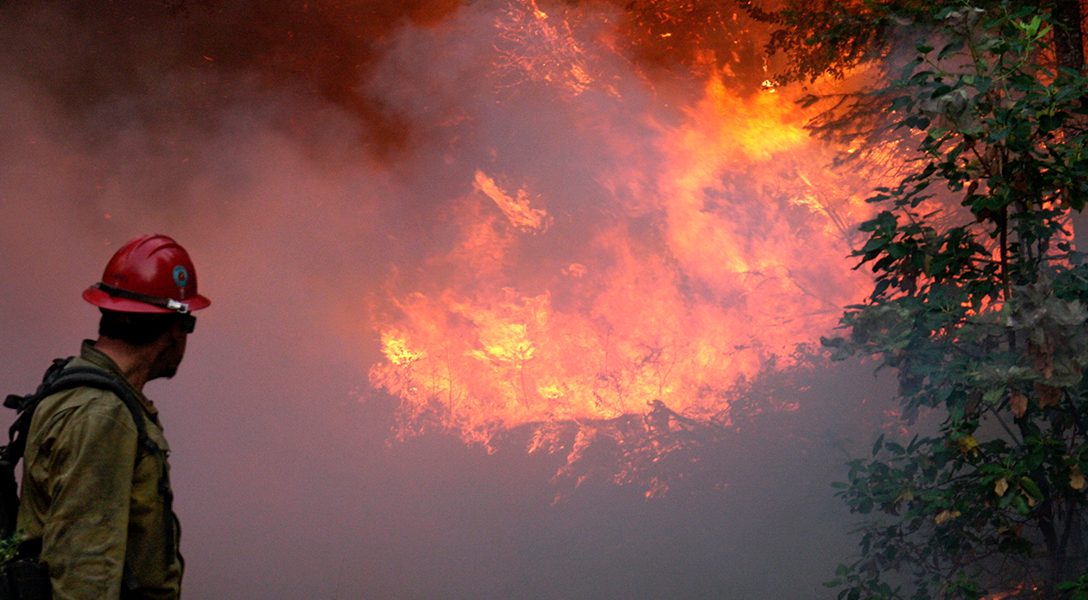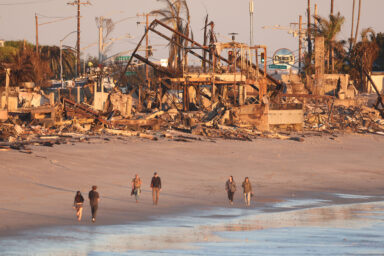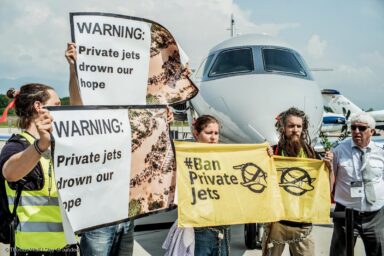WhoWhatWhy uncovers a mental health crisis among wildland firefighters.
The Santa Ana “devil winds” that race through California’s mountain canyons at 60 mph, blasting desert air across a desiccated landscape, need only a spark to whip up a devastating inferno. To beat this year’s wildfires the authorities came up with a plan that included preemptively switching off the electricity in parts of America’s most populous state — yet no one anticipated a garbage truck dumping its smoldering trash at a roadside in Riverside County.
This was one of several blazes that more than 1000 firefighters fought across California in recent days, which resulted in two deaths, scores of homes destroyed, thousands of acres charred, and 100,000 evacuated.
As wildfires grow more severe each year, wildland firefighters are contending with personal challenges that go beyond the smoke and flames — trauma, irregular sleep, longer periods of time away from family and loved ones, and the shock of returning to normal life when peak fire season comes to a close.
We are seeing fire environments that we’ve never observed before in all recorded history.
The surge in the number and severity of wildfires coincides with a sharp increase in first responder suicides. According to statistics the Firefighter Behavioral Health Alliance (FFBHA) provided to WhoWhatWhy, there were 231 fire responder suicides from 2000 to 2009. From 2010 to 2019, that number rose to 1,021, including 613 in the past 5 years. Jeff Dill, CEO of FFBHA, believes that is a significant undercount: he estimates that half of all firefighter suicides go unreported.
The ravages from fires in the US have been increasing due to changing weather conditions, such as higher temperature, lower humidity, and stronger wind events, causing bigger swaths of land to burn every year.
“We live in an era of smoke,” Dr. William Jolly, a research ecologist with the United States Forest Service (USFS), told WhoWhatWhy. “We are seeing fire environments that we’ve never observed before in all recorded history.”
From 1980 to 1999, approximately 63 million acres burned across the United States. From 2000 to 2019, 138 million acres burned.
“The first fire I fought was in 1988 in Yellowstone,” said Steve Underwood, who has been a wildland firefighter for 31 years. “The first thing I heard was ‘I’ve never seen anything like this and I’ve been doing this for twenty years.’ Now it’s like that all the time. Crazy year after crazy year.”
Wildfires are the only natural disaster that people actively fight. With more fires, the hours get longer for those on the front lines. For wildland firefighters in the United States, there is a policy that says shifts should be two weeks on, two days off. In the unpredictable world of climate change and natural disasters, it doesn’t always work that way.

Fires don’t abide by the typical 9–5 workday. This past season, for example, Alex Ehlinger, who just finished a season of wildland firefighting in New Mexico, worked a 27-hour shift.
A complex fire, with trees going up in flames and embers blowing in the wind, meant that Ehlinger and his crew had to fight through the night.
“There’s a strong machismo culture [in wildland firefighting],” Harrison Raine, who worked as a wildland firefighter for three summers in Nevada and Idaho, told WhoWhatWhy. “Firefighters pride themselves on how difficult this work is. There’s no one that’s cheering you on.”
Wildland firefighting is seasonal work. When the snow starts to fall and the flames die out, it’s time to go home. The abrupt transition is not easy. As fire seasons lengthen, it becomes harder to adjust to normal life off-season.
I’ve never seen or heard of any mental health support system
“It’s hard because you switch from being in this intense environment with a crew to the next day waking up with nothing to do, and you think to yourself, what’s my purpose?” said Raine.
Stressors from the fire season continue to burden firefighters during the winter months, when they no longer have the social and emotional support of other crew members. Ehlinger recently finished up his last fire season and is trying to figure out what to do next.
“It’s a weird letdown,” he said. “I have trouble calming down after the season, I have trouble turning it off. Even when I’m driving I’m nervous. I stop myself and think ‘what am I nervous about?’ — but I can’t find a decent answer.”
“Wildland firefighters face constant exposure to life-threatening incidents — disasters, death, destruction,” said Richard Barton, CEO of the International Critical Incident Stress Foundation. “They are exposed to painful incidents. Horrible, sad-as-you-can-imagine incidents.”
The USFS offers little support to help first responders recover from these incidents and the post-traumatic stress they can trigger.
“I’ve never seen or heard of any mental health support system,” Ehlinger said.
To become a wildland firefighter with the USFS, candidates have to complete a physical fitness test and two mandatory training courses. According to Ehlinger and Raine, these courses do not include any mental health component to prepare firefighters for how mentally and emotionally taxing the job can be.
Is California’s Largest Utility Again Ducking Liability for a Catastrophe?
Some efforts are being made on the state level to provide mental health support for wildland firefighters. On October 2, California passed two bills to improve the mental health of wildland firefighters — the SB-452 Workers’ Compensation Act, which classifies post-traumatic stress as an injury, and the California Firefighter Peer Support and Crisis Referral Services Act, which authorizes local, state, and regional fire agencies to establish a Peer Support and Crisis Referral Program. With this legislation, California set a precedent of greater mental health support for fire responders. However, national support is still lacking.
There are many incidents that can be triggering, and they may not be obvious or affect everyone the same way.
“The determining factors [of stress] are the experiences and psyche of the person affected,” said Barton. “You and I could be working together and experience the same stressor, but it could affect you very differently than it does me.”
“People don’t want to ask for help,” Raine said, “and people don’t want to tell people about the hard shit that they’re doing.”
As climate change causes longer, more complicated fire seasons, the time out in the field and the possibility of encountering stressors goes up. On the one hand, wildland firefighters love their jobs and relish busy fire seasons as a chance to perfect their skills, travel to new and beautiful places, and perform a public service. On the other hand, the intensity of their jobs can wear them down over time.
“It’s like 100 bees come after you as opposed to one,” said Barton. “When there is more to cope with than you have the resources to deal with, you can’t overcome.”
Related front page panorama photo credit: Adapted by WhoWhatWhy from GlacierNPS / Flickr.



